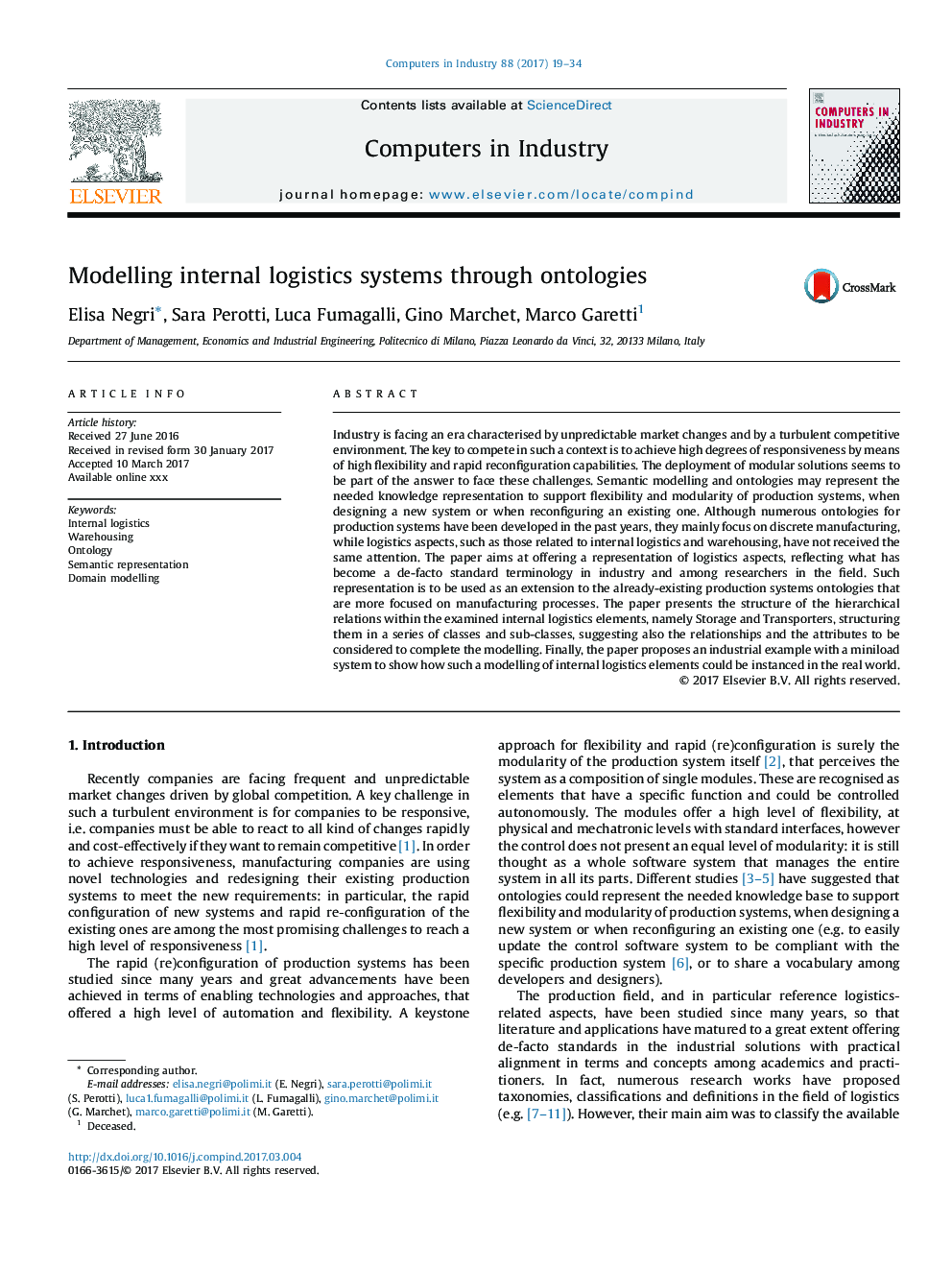| کد مقاله | کد نشریه | سال انتشار | مقاله انگلیسی | نسخه تمام متن |
|---|---|---|---|---|
| 4965568 | 1448373 | 2017 | 16 صفحه PDF | دانلود رایگان |
عنوان انگلیسی مقاله ISI
Modelling internal logistics systems through ontologies
ترجمه فارسی عنوان
مدل سازی سیستم های تدارکات داخلی از طریق هستی شناسی
دانلود مقاله + سفارش ترجمه
دانلود مقاله ISI انگلیسی
رایگان برای ایرانیان
کلمات کلیدی
تدارکات داخلی، انبارداری، هستی شناسی، نمایش معنایی، مدل سازی دامنه،
ترجمه چکیده
صنعت با دورانی مواجه است که با تغییرات بازار پیش بینی نشده و محیط رقابتی آشفته مواجه است. کلید رقابت در چنین زمینه ای، دستیابی به سطوح بالا پاسخ با استفاده از انعطاف پذیری بالا و قابلیت های سریع بازپرداخت است. استقرار راهکارهای مدولار به نظر می رسد بخشی از پاسخ به این چالش ها است. مدل سازی معنایی و هستی شناسی ها ممکن است نمایندگی مورد نیاز دانش را برای حمایت از انعطاف پذیری و مدولار سیستم های تولید، هنگام طراحی یک سیستم جدید و یا تنظیم مجدد یک موجود داشته باشند. گرچه بسیاری از هستی شناسان برای سیستم های تولیدی در سال های گذشته توسعه یافته اند، آنها عمدتا بر تولید گسسته تمرکز می کنند، در حالی که جنبه های لجستیک، نظیر مربوط به تدارکات داخلی و انبارداری، مورد توجه قرار نگرفته اند. هدف مقاله، ارائه یک نمایندگی از جنبه های لجستیک، منعکس کننده آنچه که تبدیل به اصطلاحات استاندارد در صنعت و در میان محققان در این زمینه است. چنین بازنمایی باید به عنوان یک فرمت به هستی شناسی سیستم های تولیدی که در حال حاضر بیشتر بر فرآیندهای تولید تمرکز دارد، استفاده شود. این مقاله ساختار روابط سلسله مراتبی را درون عناصر تدارکات داخلی مورد بررسی قرار می دهد، یعنی ذخیره سازی و حمل و نقل، ساختار آنها را در یک سری از کلاس ها و زیر کلاس ها، و همچنین نشان می دهد که روابط و ویژگی های مورد نیاز برای تکمیل مدل سازی. در نهایت، مقاله یک مثال صنعتی با سیستم حداقل بار ارائه می دهد تا نشان دهد که چطور چنین الگویی از عناصر تدارکات داخلی را می توان در دنیای واقعی تنظیم کرد.
موضوعات مرتبط
مهندسی و علوم پایه
مهندسی کامپیوتر
نرم افزارهای علوم کامپیوتر
چکیده انگلیسی
Industry is facing an era characterised by unpredictable market changes and by a turbulent competitive environment. The key to compete in such a context is to achieve high degrees of responsiveness by means of high flexibility and rapid reconfiguration capabilities. The deployment of modular solutions seems to be part of the answer to face these challenges. Semantic modelling and ontologies may represent the needed knowledge representation to support flexibility and modularity of production systems, when designing a new system or when reconfiguring an existing one. Although numerous ontologies for production systems have been developed in the past years, they mainly focus on discrete manufacturing, while logistics aspects, such as those related to internal logistics and warehousing, have not received the same attention. The paper aims at offering a representation of logistics aspects, reflecting what has become a de-facto standard terminology in industry and among researchers in the field. Such representation is to be used as an extension to the already-existing production systems ontologies that are more focused on manufacturing processes. The paper presents the structure of the hierarchical relations within the examined internal logistics elements, namely Storage and Transporters, structuring them in a series of classes and sub-classes, suggesting also the relationships and the attributes to be considered to complete the modelling. Finally, the paper proposes an industrial example with a miniload system to show how such a modelling of internal logistics elements could be instanced in the real world.
ناشر
Database: Elsevier - ScienceDirect (ساینس دایرکت)
Journal: Computers in Industry - Volume 88, June 2017, Pages 19-34
Journal: Computers in Industry - Volume 88, June 2017, Pages 19-34
نویسندگان
Elisa Negri, Sara Perotti, Luca Fumagalli, Gino Marchet, Marco Garetti,
